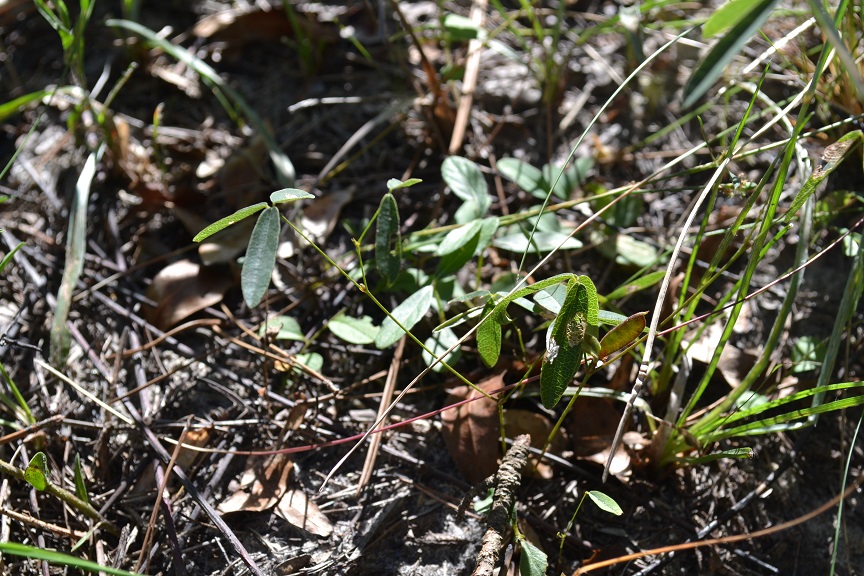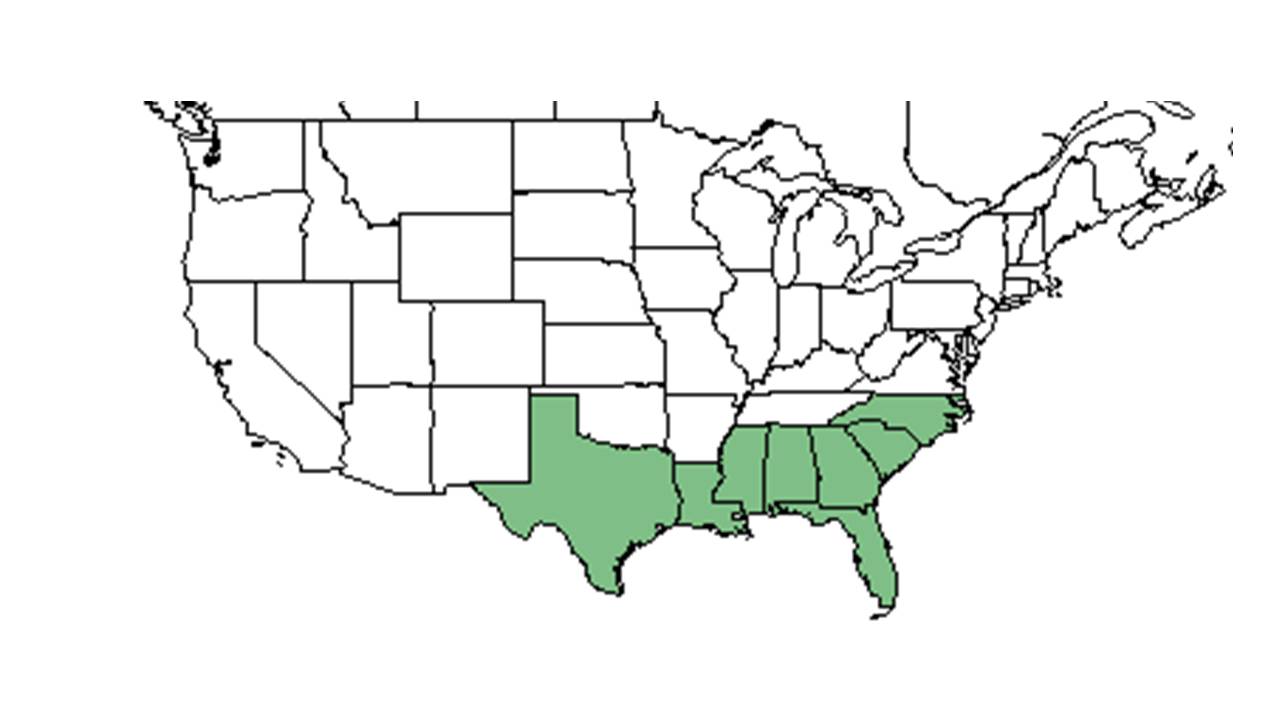Galactia erecta
| Galactia erecta | |
|---|---|

| |
| Photo taken by Kevin Robertson | |
| Scientific classification | |
| Kingdom: | Plantae |
| Division: | Magnoliophyta - Flowering plants |
| Class: | Magnoliopsida – Dicotyledons |
| Order: | Fabales |
| Family: | Fabaceae ⁄ Leguminosae |
| Genus: | Galactia |
| Species: | G. erecta |
| Binomial name | |
| Galactia erecta (Walter) Vail | |

| |
| Natural range of Galactia erecta from USDA NRCS Plants Database. | |
Common name: erect milkpea
Contents
Taxonomic notes
Synonyms: none[1]
Varieties: none[1]
Description
This plant is erect[2].
Generally, the genus Galactia are "trailing or twining, climbing, perennial, herbaceous or woody vines or erect, perennial herbs or rarely shrubs. Leaves 1-pinnate, usually 3-foliolate (or rarely 1-,5-7-,9-folilolate); leaflets entire, petiolulate, stipellate. Racemes axillary, pedunculate with few to numerous, papilionaceous flowers borne solitary or 2-several at a node, ech subtended by a bract and fusion of the 2 uppermost, with the laterals usually shorter than the uppermost and lowermost; petals usually red, purple, pink or white; stamens diadelphous or elsewhere occasionally monadelphous; ovary sessile or shortly stipitate. Legume oblong-linear to linear, few-many seeded, compressed, straight or slightly curbed, dehiscent with often laterally twisting valves."[3]
Specifically, for G. erecta species they are "erect perennial with glabrous or sparsely pubescent stems, mostly 2-4 dm tall. Leaves 3-foliolate with rachis 1-2 mm long; leaflets linear-oblong to oblong or elliptic, mostly 1.5-4 cm long, glabrous. Racemes 1-2 cm long, subsessile; flowers 1-6, on short-pubescent pedicels 1-3 mm long subtended by triangular-subulate bracts 1-1.5 mm long; bractlets triangular-to linear-subulate, 1-2 mm long. Calyx appressed short-pubescent, tube 2-3 mm long, lobes 2-3 mm long; petals pale purple to white, the standard 7-8 mm long. Legume 2-4 cm long, 5-8 mm broad, 6-10 seeded, with short-pubescent valves and sutures." [3]
Distribution
G. erecta is distributed from southeast North Carolina south to the panhandle of Florida, and west to eastern Texas.[1]
Ecology
Habitat
Generally, G. erecta can be mostly found in sandhills within the southeastern coastal plain.[1] This species has been found in open longleaf pine-wiregrass flatwoods along gum swamps, wiregrass savannas, pine-oak upland forests, and clearings within pine flatwoods. This species does well in open light environments in dry loamy sands, drying sand, and sandy-peaty wet soils.[2] G. erecta is vulnerable to disturbance, and is more often found in native groundcover areas.[4] It is considered an indicator species of the Florida panhandle silty longleaf woodlands habitat as well.[5] G. erecta was found to decrease its occurrence in response to soil disturbance by agriculture in southwest Georgia. It has shown resistance to regrowth in reestablished native savannas that were disturbed by agricultural practices.[6] Additionally, G. erecta was found to a decreaser in its short-term response to single mechanical soil disturbances as well as in its long-term response following cessation of repeated soil disturbance.[7]
Associated species seen growing with Galactia erecta include Pinus palustris, Pinus elliotii, Aristida stricta, Quercus species, Tephrosia florida, Aristida, Croton, Berlandiera, Asclepias, Tetragonotheca, Galactia mollis. [2]
Galactia erecta is an indicator species for the Panhandle Silty Longleaf Woodlands community type as described in Carr et al. (2010).[8]
Phenology
G. erecta has been observed to have corolla white or light yellowish flowers.[2] “A purple flowered perennial herb about 1 foot high, occurring in dry pine lands of the Coastal Plain from north Carolina to Louisana. Seeds have been recorded from stomach of a single bobwhite.”[9] It has been seen flowering from April to August with peak inflorescence in May and June.[2][10] It has been observed fruiting from June to July and in September.[2]
Seed dispersal
This species is thought to be dispersed by gravity. [11]
Fire ecology
Galactia erecta has been found in recently burned open scrub and is a characteristic species of various fire-dependent habitats.[2][5] It was found that the mean density of G. erecta increases with fire disturbance reintroduction,[12] and populations have been known to persist through repeated annual burning.[13]
A study describing the effects of a seasonal fire regime on legume reproduction in longleaf pine savannas found that G. erecta produces the most flowers after a late winter/early spring burn (10.9), with flowers decreasing in number after a lightning-season burn (10.2) or after instances without fire (8.4).[14] This study also found that the duration of synchronous flowering was greatest after instances of no fire (142.7 days) and decreased after a late winter/early spring burn (142.3 days) and after a lightning-season burns (77 days).[15] Additionally, the peak flowering activity occurred earliest after instances without fire (190.7 Julian) and occurred later after a late winter/early spring burn (206.3 Julian) and after a lightning-season burn (246.0 Julian).[16] It seems to benefit most from winter and spring burn regiments rather than summer burn regiments with both overall occurrence and biomass.[17]
Herbivory and toxicology
Species in the genus Galactia have been observed to be eaten by gopher tortoises (Gopherus polyphemus).[18]
Conservation, cultivation, and restoration
It is listed as G4 on the global scale due to its restricted distribution. G. erecta is also critically imperiled in Texas as well as vulnerable in North Carolina.[19]
Cultural use
Photo Gallery
References and notes
- ↑ 1.0 1.1 1.2 1.3 Weakley, A.S. 2020. Flora of the Southeastern United States. Edition of 20 October 2020. University of North Carolina at Chapel Hill, Chapel Hill, North Carolina.
- ↑ 2.0 2.1 2.2 2.3 2.4 2.5 2.6 Florida State University Robert K. Godfrey Herbarium database. URL: http://herbarium.bio.fsu.edu. Last accessed: June 2014. Collectors: Loran C. Anderson, John B. Nelson, R.K. Godfrey, Washington, Loran C. Anderson, Rodie White, William B. Fox, H. L. Blomquist, Sidney McDaniel, H. R. Reed, R. L. Wilbur, Samuel B. Jones, F. H. Sargent, Harry E. Ahles, J. Haesloop, and R. Kral. States and Counties: Florida: Wakulla, Jackson, Bay, Walton, Liberty, and Gadsden. Georgia: Thomas, Baker, and Dodge. North Carolina: Bladen and Onslow. Mississippi: George, McNeill, Lamar, and Pearl River. Alabama: Baldwin and Clarke.
- ↑ 3.0 3.1 Radford, Albert E., Harry E. Ahles, and C. Ritchie Bell. Manual of the Vascular Flora of the Carolinas. 1964, 1968. The University of North Carolina Press. Print.
- ↑ Kirkman, L. K., et al. (2004). "Ground Cover Recovery Patterns and Life-History Traits: Implications for Restoration Obstacles and Opportunities in a Species-Rich Savanna." Journal of Ecology 92(3): 409-421.
- ↑ 5.0 5.1 Carr, S. C., et al. (2010). "A Vegetation Classification of Fire-Dependent Pinelands of Florida." Castanea 75(2): 153-189.
- ↑ Kirkman, L.K., K.L. Coffey, R.J. Mitchell, and E.B. Moser. Ground Cover Recovery Patterns and Life-History Traits: Implications for Restoration Obstacles and Opportunities in a Species-Rich Savanna. (2004). Journal of Ecology 92(3):409-421.
- ↑ Dixon, C. M., K. M. Robertson, A. M. Reid and M. T. Rother. 2024. Mechanical soil disturbance in a pine savanna has multiyear effects on plant species composition. Ecosphere 15(2):e4759.
- ↑ Carr, S.C., K.M. Robertson, and R.K. Peet. 2010. A vegetation classification of fire-dependent pinelands of Florida. Castanea 75:153-189.
- ↑ Graham, E. H. (1941). Legumes for erosion control and wildlife. Washington, USDA
- ↑ Nelson, G. PanFlora: Plant data for the eastern United States with emphasis on the Southeastern Coastal Plains, Florida, and the Florida Panhandle. www.gilnelson.com/PanFlora/ Accessed: 9 DEC 2016
- ↑ Kirkman, L. Katherine. Unpublished database of seed dispersal mode of plants found in Coastal Plain longleaf pine-grasslands of the Jones Ecological Research Center, Georgia.
- ↑ Duncan, R. S., et al. (2008). "The effect of fire reintroduction on endemic and rare plants of a southeastern glade ecosystem." Restoration Ecology 16: 39-49.
- ↑ Robertson, K.M. Unpublished data collected from Pebble Hill Fire Plots, Pebble Hill Plantation, Thomasville, Georgia.
- ↑ Hiers, J. K., et al. (2000). "The effects of fire regime on legume reproduction in longleaf pine savannas: is a season selective?" Oecologia 125: 521-530.
- ↑ Hiers, J. K., et al. (2000). "The effects of fire regime on legume reproduction in longleaf pine savannas: is a season selective?" Oecologia 125: 521-530.
- ↑ Hiers, J. K., et al. (2000). "The effects of fire regime on legume reproduction in longleaf pine savannas: is a season selective?" Oecologia 125: 521-530.
- ↑ Kush, J. S., et al. (2000). Understory plant community response to season of burn in natural longleaf pine forests. Proceedings 21st Tall Timbers Fire Ecology Conference. Fire and forest ecology: innovative silviculture & vegetation management, Tallahassee, FL, Tall Timbers Research, Inc.
- ↑ Birkhead, R. D., et al. (2005). "Patterns of folivory and seed ingestion by gopher tortoises (Gopherus polyphemus) in a southeastern pine savanna." American Midland Naturalist 154: 143-151.
- ↑ [[1]] NatureServe Explorer. Accessed: May 13, 2019